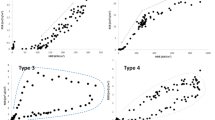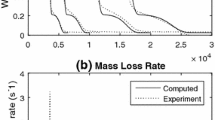Abstract
A semi-empirical model was developed to use the radiant coal power of cigarettes in non-contact free smolder to predict the percentage of cigarettes smoldering on 10 layers of filter paper from a sample set that would burn the entire length of the tobacco rod. To develop the model the radiant coal power for cigarettes in non-contact free smolder was measured using infrared imaging and the percentage of the same type of cigarettes smoldering on 10 layers of standard chemical filter paper that burned the entire length of the tobacco rod was measured. From the experimental data, a characteristic coal power and an effective extinguishment threshold were established for the cigarettes. The effective extinguishment threshold was plotted as a function of the characteristic coal power for different cigarette designs, and the optimized Boltzmann model of the data allows the percentage of cigarettes smoldering on 10 layers of filter paper that would burn the entire length of the tobacco rod to be predicted by measuring the radiant coal power for the cigarettes in non-contact free smolder. The model was also used to predict the percentage of cigarettes smoldering on 7 layers of filter paper that would burn the entire length of the tobacco rod. The percentages predicted shows good agreement with the percentages measured for both 7 and 10 layers of filter paper.
Similar content being viewed by others
References
R.G. Gann, R.H. Harris, Jr., J.F. Krasny, R.S. Levine, H.E. Mitler, and T.J. Ohlemiller, “The Effect of Cigarette Characteristics on the Ignition of Soft Furnishings,” Technical Note 1241, National Bureau of Standards, Gaithersburg, MD, 1988.
T.J. Ohlemiller, K.M. Villa, E. Braun, K.R. Eberhardt, R.H. Harris, Jr., J.R. Lawson, and R.G. Gann, “Test Methods for Quantifying the Propensity of Cigarettes to Ignite Soft Furnishings,” Special Publication 851, vol. 2, National Institute of Standards and Technology, Gaithersburg, MD, 1993.
American Society of Testing and Materials (ASTM), “Standard Test Method for Measuring the Ignition Strength of Cigarettes,” Standard E2187-04, ASTM International, West Conshohocken, PA, 2002.
B.E. Waymack, D.S. Kellogg, D.D. McRae, and R.W. Dwyer, “Watts in a Cigarette: Thermophysical Properties of Smoldering Cigarettes,” Tobacco Science, vol. 41 July 1997, pp. 74–81.
R.L. Rice, R.S. Perrier, and V.C. Runeckles, “A Weight Loss Technique for Determining Rate of Static Burn,” Tobacco Science, vol. 14, 1970, pp. 173–175.
See for example Patent Literature.
S.C. Yi, E.S. Song, S.G. Oh, S.Y. Bae, S.K. Moon, and M.R. Hajaligol, “Theoretical Analysis of the Effects of Cigarette Design Parameters on the Smoldering Rates, Heat Flux, and Total Heat Released during Smoldering of a Cigarette,” Journal of Fire Sciences, vol. 19, 2001, pp. 18–30.
M. Muramatsu, S. Umemura, and T. Okada, “A Mathematical Model of Evaporation-Pyrolysis Processes Inside a Naturally Smoldering Cigarette,” Combustion and Flame, vol. 36, 1979, pp. 245–262.
H.E. Mitler and G.N. Walton, “Modeling the Ignition of Soft Furnishings by a Cigarette,” Special Publication 852, Vol. 3, National Institute of Standards and Technology, Gaithersburg, MD, 1993.
N.A. Moussa, T.Y. Toong, and C.A. Garris, “Mechanism of Smoldering of Cellulosic Materials,” Sixteenth Symposium (International) on Combustion, The Combustion Institute, Pittsburgh, 1977, pp. 1447–1457.
R.R. Baker and D.P. Robinson, “Tobacco Combustion — The Last Ten Years,” Recent Advances in Tobacco Science, vol. 16, 1990, pp. 3–71.
A.T. Lendvay and T.S. Laszlo, “The Thermal Emittance of Cigarette Coal,” Beiträge zur Tabakforschung, vol. 8, 1976, pp. 283–285.
C.S. Lyman, T.A. Perfetti, D.M. Riggs, and W.T. Morgan, “Thermal Emissivity and Cigarette Coal Temperature During Smoldering, Beiträge zur Tabakforschung, vol. 20, 2003, pp. 381–388.
G.A. Gabriele, and K.M. Ragsdell, “The Generalized Reduced Gradient Method: A Reliable Tool for Optimal Design,” ASME J. Engin Ind., Series B, vol. 99, no. 2, 1977, pp. 394–400.
L.S. Lasdon, A.D. Waren, A. Jain, and M. Ratner, “Design and Testing of a Generalized Reduced Gradient Code for Nonlinear Programming,” ACM Transactions on Mathematical Software, vol. 4, no. 1, 1978, pp. 24–50.
D. Fylstra, L. Lasdon, J. Watson, and A. Waren, “Design and Use of the Microsoft Excel Solver,” INTERFACES, vol. 28, no. 5, 1998, pp. 29–55.
D.M. Levine, P.P. Ramsey, and R.K. Smidt, Applied Statistics for Engineers and Scientists, Prentice Hall, 2001, pp. 567–615.
Author information
Authors and Affiliations
Additional information
An erratum to this article is available at http://dx.doi.org/10.1007/s10694-006-0217-4.
Rights and permissions
About this article
Cite this article
Sherwood, T.S., Issac, J.C., Murthi, R.M. et al. Semi-Empirical Model using Radiant Coal Power to Predict Cigarette Ignition Strength as Measured by Extinction Test. Fire Technol 42, 233–251 (2006). https://doi.org/10.1007/s10694-006-7507-8
Published:
Issue Date:
DOI: https://doi.org/10.1007/s10694-006-7507-8




